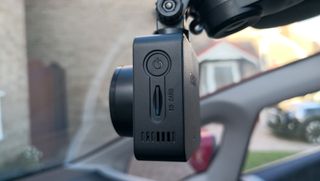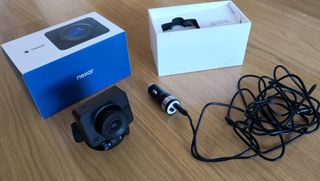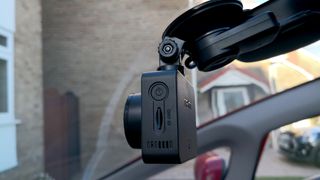If you’re looking for a dash cam that’s relatively simple to set up, then the Nexar Beam is a very solid choice. It’s keenly priced, too, and has the added benefit of being able to keep all of your video clips stored in the cloud, without charge.
In terms of specs, the Nexar Beam also features a very respectable range of features and functions. It’ll capture 1080p full HD video while the GPS functionality adds a little more meat on the bones of this compact camera. There’s a 135-degree field of view from the lens, plus plenty of cable and all the fixtures and fittings needed to get up and running.
Better still, Nexar knows a thing or two about dash cams, so getting yourself kitted out with one of these means you’ll be getting access to a well-proven recording format that shouldn’t let you down. With more of us opting to have on-board video recording in the car, the Nexar Beam makes a great entry-level model to go for. Of course, Nexar has more advanced models to head for if you need extra recording muscle, like the Nexar Pro dash cam we’ve also looked at recently.
Sticking with the beginner friendly Nexar Beam, though, things get off to a great start as you lift it out of the box for the first time. This isn’t going to win any awards on the design front and what you see is what you get. The Nexar Beam looks rather like a boxy budget action camera, with little in the way of frills. There’s no rear screen, but aside from that everything is where it should be. You can also pop in your own microSD card if you want beefier storage.
You get an impressively long three-meter long connection cable, which connects from the camera and runs back to your in-car power socket. There’s even a tool supplied, so you can push the cable in behind the headliner or door pillars for a less intrusive, out-of-the-way look. Another key component of the package is the GPS mount, which boasts a suction pad that helps you get the camera into position on your windscreen and ensure it stays that way. This can also be un-suctioned and moved if you need to switch it to another car, or aren’t happy with the current position.
Setting up the Nexar Beam is very straightforward. Three leaflets inside the box explain the steps and offer tips on how to fine-tune the system to suit your needs. You’ll need to download the Nexar app, either for iOS or Android and select the setting options as prompted. This includes how much space for recording is allocated to your phone. There are also visual instructions on how to assemble the camera and GPS mount, as well as plumbing in the cable. The plug end for your power socket in the car also has a spare USB socket for plugging your phone into, which is handy as power gets sapped during camera activity.
After pairing the camera with your phone, you’re ready to go. Usefully, the camera shows a variety of different colored indications depending on its status. A steady green light shows it’s on and active. Blinking red means it’s upgrading. A steady red light highlights a technical issue, while the blinking blue indicator means it needs to be paired to your phone again. Meanwhile, a steady blue light means the dash cam and your phone are paired.
The Nexar app isn’t bad and the automatic upload of captured video to your free cloud storage is a boon with the Beam. However, while everything works well enough, once you’ve got it set up the recording process seems a little disjointed. It took us a little bit of practice to work out when recording was taking place, and how to find the respective clips in our online account. Once you get your head around it, though, the procedure is much easier.
As for the quality of the recordings, we were happy with the overall look of the video. The camera works well in all sorts of conditions too, with impressive results recorded at dusk and into the night.
The Nexar Beam also copes well in harsh early morning light, direct sunshine and inclement weather too. It’s a solid all-rounder in that respect, while the resolution is more than acceptable and can be used without fear in the event of any incidents. The associated time and date information is also clearly displayed.
You’ll want to keep your phone plugged into the power, though, as Wi-Fi and Bluetooth can sap the battery as the camera interacts with your device.
However, the ability to capture GPS data, which is presented in a map of your route on the app or in the cloud space (below) is a neat supplement to the generally impressive video on offer.










